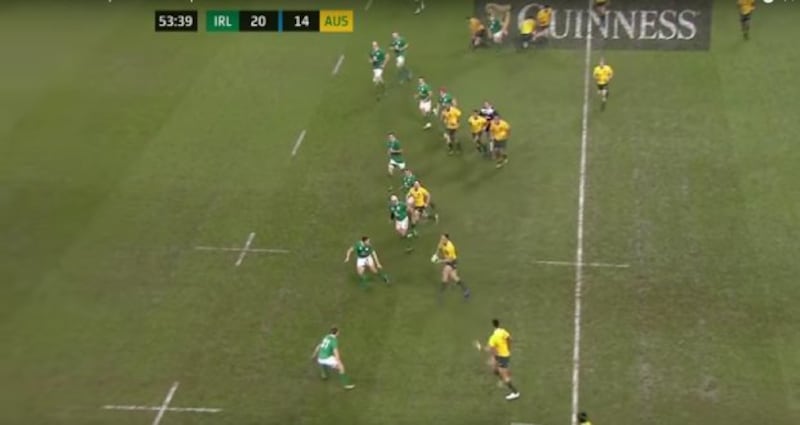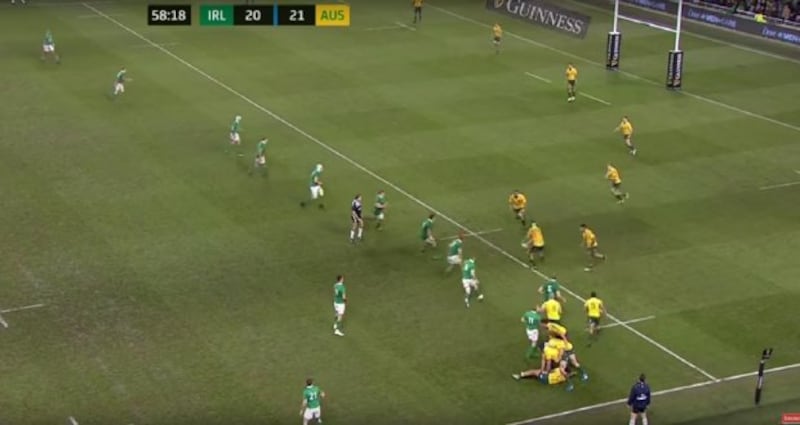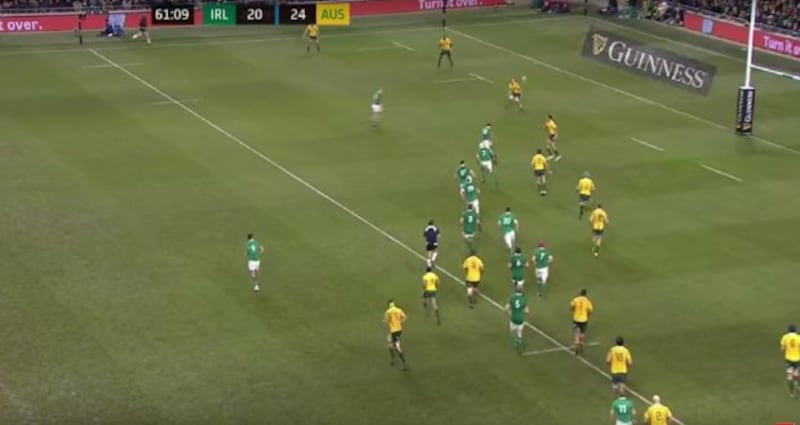The idea of a Johnny Sexton sabbatical doesn’t really work, but a fully fit version of him does. Comments like that can be dangerous but there does need to be a balance between constantly rushing him back for matches and resting him just for the sake of it.
Where is the logic of resting Johnny for December, if available, when he can still get injured in January? Being wrapped in cotton wool doesn’t help a rugby player. Being battle hardened does. So if fit, they should play.
But, before addressing that issue in more detail, there’s a wealth of on-field analysis coming out of Saturday’s game.
Many people may still be wondering how Ireland escaped with a victory?
Problem solving on the pitch during November’s international window has been an area of real growth for the squad. Normally we would be looking back on the Monday morning after another brave three-point defeat that was all our own doing. That frustration is Australia’s alone.
Michael Cheika’s initial reaction was to heap blame on the referee by referencing the 13-3 penalty count.
This defeat must be very hard for the Wallabies to swallow, much like New Zealand struggled to compute what transpired in Chicago – hence their reaction in Dublin.
Ireland are supposed to roll over and die in these Test matches. Or at the very least fade away, heroically. But that psychological advantage has now swung in our favour.
I was talking to Michael Lynagh afterwards and I asked him if he had any argument about the disciplinary imbalance.
“Absolutely not,” said the great Wallaby outhalf.
Penalty count
The penalty count should have been 14-3 as David Pocock got away with a turnover on Simon Zebo after his legs came in the gate but his upper body did not.
Dean Mumm and Bernard Foley were sin binned for blatant tip tackles.
That’s two more penalties that cannot be disputed. Ireland are sending the match officials correct clear messages. The discipline this month – 11 penalties in the three big games – is astonishing, but the problem solving supersedes everything because it guaranteed victory.
A backline torn to shreds by the physicality of the All Blacks still managed to figure out and plug so many glaring holes when Australia threatened to cut loose. That in itself is of enormous benefit moving forward to the Six Nations; these players have the confidence to make essential adjustments.
The result was not down to the refereeing of Jerome Garces, nor was Jaco Peyper the reason we lost to New Zealand.
Now, the All Blacks wouldn’t have spurned the multiple opportunities the Wallabies created in the second half. Not a chance.
I also liked Joe Schmidt finding fault with Garry Ringrose’s performance. That’s Joe asking “Can you be better?”, or just relaying a public message about how the group functions.
Same goes for his comments on Joey Carbery and Kieran Marmion. He spoke about still not knowing if either can control a Test match from halfback but their courage is at least clear to see.
Ringrose, Keith Earls and Marmion survived the constant Wallaby onslaught of huge men being launched towards them by problem solving, literally, on their feet. Yes, Robbie Henshaw would have brought a greater physicality in contact from inside centre but Garry did his job, he made the majority of his tackles – he was swatted off by Israel Folau once but Ireland were never badly exposed by his defending.
This proved crucial. Figuring out the need for increased line speed at crucial moments denied Australia tries and Richie Murphy was on the right touchline giving Marmion a running tutorial on how a winger must defend.
A scrumhalf at right wing, an outhalf with only 13 professional games at fullback, a winger at outside centre and an outside centre winning his third cap at inside centre – I think Ireland coped exceptionally well when we consider the world-class attacking Wallaby threat.

When Jared Payne couldn’t return for the second half, the Wallabies knew exactly where they must pour their attacking resources. Straight at Marmion. The Connacht scrumhalf struggled initially – who wouldn’t? – before defending the edge efficiently by sprinting up late, and so denying the kicking option, all the while staying square so he could cover all the attacking options.

The Irish line speed made huge improvements from one damaging Wallaby attack to the next, all in the space of three hectic minutes.
A clear example of problem solving was evident for the game defining moment: in the 59th minute, with the scoreboard at 20-21 and Ireland looking set to crumble, the Wallabies attacked from inside their 22. Slow line speed allowed Folau carry between Ringrose and Rory Best before offloading for Tevita Kuridrani.

Kuridrani feeds Dane Haylett-Petty who raced 70 odd metres before Carbery tackled him.

Ireland were in all sorts of trouble until Marmion raced up and stopped Folau from offloading right on the Irish 22. It was a certain try. They left our territory with three points; making it 20-24 but every single man in a green jersey was blowing hard.
From the next kick off Australia found themselves in exactly the same position on their 22, near the left touchline. Away they went again but the difference in Irish line speed, at that crucial moment, played a huge role in this victory.

That had to be a message delivered by Rory or Jamie under the Irish posts when Bernard Foley was kicking his penalty. That is a team and its leaders figuring out their weaknesses in the heat of battle. Not many teams have the intellect to do this under that amount of strain.
The result? Instead of Australia running the length of the field again, Zebo arrived with a man-and-ball hit before Michael Hooper could get possession wide to Kuridrani and Haylett-Petty.

From such actions, a team improving on the run, is how a team becomes champions. Now, nothing is won in November 2016 but it proved a complete momentum changer as within four minutes Earls ran in his try and Ireland win 27-24.
Ireland must develop this process, of solving problems in real time, over the rest of the season. Of course there is so much more to it than that. Like Rory’s decision making. Unlike the All Blacks game in Dublin he ignored several three-point opportunities to hunt down a try. Now, it ended up with Paddy Jackson kicking a penalty after 16 minutes, to make it 3-0, but Australia had been defending their try line for that whole period.
We must also talk about the improved depth of the Ireland squad. Just because we are building depth, which we so clearly are, it doesn’t mean we have the necessary depth yet.Jackson has narrowed the gap on Sexton, a little. We know Paddy can thrive as an international outhalf now because he backed up the June tour of South Africa, especially against Australia, with his place-kicking.
But Sexton remains crucial to Ireland capturing silverware, or winning another Grand Slam and beyond to the Lions tour of New Zealand. It’s not a criticism of Paddy, who is 24, it is a reflection on Johnny, who at 31 is at the peak of his powers. Same goes for Seánie O’Brien.
Highest paid assets
Yes, they both get injured more than most but they are the highest paid assets in the IRFU playing pool (along with Jamie Heaslip) so of course Leinster want them for Champions Cup games.
If they are fit they play in all the big games, be it for Leinster or Ireland. If not they don’t. If they get injured playing for Ireland then Leinster suffer as a result, and vice versa. Well, that’s just the life of a rugby player.
Leinster do have viable alternatives. Carbery and particularly Josh van der Flier’s performances – while they are not of Johnny or Seanie levels yet – represent a promising future so the loss of either is not as keenly felt as it was in other seasons.
If Johnny’s hamstring recovers, we see him against Northampton in December. If not, it will be January or the Six Nations.
When fit, they play. That’s it. When not, Carbery or Jackson wear 10 and Van der Flier plays openside.
I hope the players are consulted in this process. Johnny Sexton wants to be the Leinster and Ireland outhalf for as long as possible. I’m sure he wants to go on another Lions tour so that means he needs to get himself in the best possible shape. Part of this process is about striking a balance between training load, minutes on the pitch and games per season.
Johnny has been playing rugby since he could hold a ball and loves the game with all his heart. In professional sport it is easy to forget that every one of these guys would play for free. They are doing what they love. Also, every time he doesn’t play it gives Paddy or Joey opportunities to close the gap. Same goes for George Ford or Dan Biggar.
That means he needs to be at full fitness.
Gone are the days when it was harder to get out of an Ireland jersey than it was to get into it. Gone also are the days when a player can expect to play five or six years without an injury (unless he is Jamie).
The game has changed dramatically on Joe’s watch and he continues to expose players so we develop the depth to cope. We are building that depth, we don’t have it yet, but November proves that this group are on the most progressive pathway I can remember for Irish rugby.












